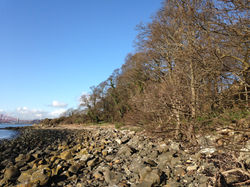Flowers at the Heritage Viewpoint - Spring versus Autumn seed sowing and Spring Drought

I am sure many of you who remember the wonderful wildflower display we had at this time last year at the Heritage Viewpoint may be wondering why there is not the same colourful show this year.
Most of the colour last year came from the Cornfield Annuals that were concentrated on each side of the Coastal Path, though the Poppies in early June last year stretched down the bank as well. A photo of the bank taken earlier in June this year shows just how different this year is.

The same is true when a different view is compared, though it is not completely without flowers this year.


Why then is the wild flower display this year so different?
An obvious difference from last year has been the lack of rain this spring. This year we only had 28 mm over the 75 days between the 18 March and the 2nd June, while in the same period in 2019, we had 121 mm, but this is not the only reason. We were late in getting the ground prepared because of all the winter rain and, unlike at The Triangle, we did not get the planned sowing this spring of some supplementary seed, collected from last year’s abundance, as Covid 19 lockdown put a stop to our work parties. But even at The Triangle, now benefiting from the recent rain, the lack of Spring rain means that the Poppies and Cornflowers that are now coming into flower are much smaller than we would have expected based on past year’s experiences.

But not everything has been affected by the drought. The seed mixes we sowed in 2018 had a range of perennials as well as the spectacular Cornfield Annuals. One of these, Viper’s Bugloss looks quite spectacular, especially on the fence and hedge side of the path. Their vivid blue-purple flowers are also providing some vital nectar for bumblebees.


Another drought resistant flower which can be seen all over the area are the patches of pale-yellow Kidney Vetch, part of our 2018 seed mix and another important flower, especially for long tongued bees.
The effect of spring rather than autumn seed sowing can be seen in the test plots of Cornfield Annuals I have in my garden. Part of the area was sown at the end of August 2019, as was done for the Heritage Viewpoint in 2018, and part was sown in January 2020 at the same time as The Triangle was sown. The other section was also cleared at the end of August, but having seen that there were developing plants there, it was not sown in January. Despite all having to survive on the meager spring rains, the autumn sown seeds, and those developing in the disturbed ground, have developed to large plants just coming into flower when the photo was taken in early June, while the early spring sown plants are sparse and stunted. This whole area had been used in the previous summer to grow additional Cornfield Annuals for seed collection so the section cleared in August, but not planted in January, had seedlings developing from those seeds in the soil seed bank.

As dry springs appear to be an increasing feature of our climate here, to ensure a colourful display of Cornfield Annuals at selected locations in future years, it is going to be vital to sow in autumn and not spring.
Why then do we normally sow in spring? I think it is because there is an assumption, probably coming from long established garden practice for plants that are often frost tender, that seeds should be sown in spring. But this is not when our wildflowers themselves scatter their seeds, this happens naturally in late summer and early autumn. Experience with the Heritage Viewpoint 2018 sowing and the Garden Test plot this year have shown that if the young plants get into growth before the coldest winter weather, they can survive even occasional quite hard frosts and snow. Building on this experience, and as we now have much milder winters as well, the target for future sowing of Cornfield Annual and other wildflower seeds will be to clear the ground and complete seed sowing by the end of November.
In the meantime, there are plenty of wild flowers to be seen elsewhere around the Heritage Viewpoint and on our longer established Crow Wood Bank with its good selection of well grown perennials.







































